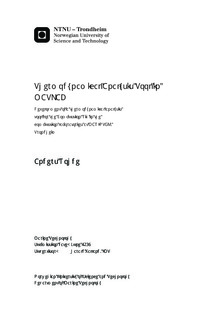| dc.contributor.advisor | Valland, Harald | nb_NO |
| dc.contributor.author | Rohde, Anders | nb_NO |
| dc.date.accessioned | 2014-12-19T12:12:16Z | |
| dc.date.available | 2014-12-19T12:12:16Z | |
| dc.date.created | 2014-09-05 | nb_NO |
| dc.date.issued | 2014 | nb_NO |
| dc.identifier | 744085 | nb_NO |
| dc.identifier | ntnudaim:11360 | nb_NO |
| dc.identifier.uri | http://hdl.handle.net/11250/239001 | |
| dc.description.abstract | To meet the increasing world populations need for transportation, fossil fueled ships will are ready to offer their services. Less fuel fuel consumed per cargo unit transported, is favourable for both the operator and the enviroment. Reduced fuel consumption means less money spent on fuel and less pollution to the air. Stricter regulations regarding air pollutions from ship also requiare actions to be take to meet these.Better understanding of the combustion processes, is an important factor to improve the diesel and gas engines operating around the world today. To obtain this understanding and knowledge, experiments needs to be performed. Knowing the proper test conditions during an experiment is vital to improve the accuracy of the results.This thesis have coped with a way to improve the experiments performed in a fixed volume combustion rig at MARINTEK. The problem at current time is to have a proper estimate of the gas compsiton in the righ when the test fuel is injected. Creating the proper test temperature and pressure is made by the combustion of a combustable gas. The problem is to know how much of the combustable species in the gas that have actually combusted.Estimating the compostion have been done by creating a two-zone model, where the unburned gas is in one and the completely combusted is in the other. This make a set of four differential equations, that is solved simultaniously. Input to these calculations is the measured pressure from a finished experiment. The calcualations is performed offline after an experiment is performed.Based on the estimate of the composition after solving the two-zone model, an estimate for the rate of heat release from the gas combustion is calculated based on the mass of gas burned and the exact known composition of the combustables. A estimate for the ROHR of the test fuel is calculated, using a closed system analysis. The a plot of the ROHR for the pre-combustion and injection experiment is displayed in a graphical user interface developed for this purpose.Accuracy of the assumptions and methodes used is discussed, and suggestions for improvements and future work is implemented in the disucussion. | nb_NO |
| dc.language | eng | nb_NO |
| dc.publisher | Institutt for marin teknikk | nb_NO |
| dc.title | Thermodynamical Analysis Tool in MATLAB: Development of a thermodynamical analysis tool for the Combustion Rig in the combustion laboratories at MARINTEK, Trondheim | nb_NO |
| dc.type | Master thesis | nb_NO |
| dc.source.pagenumber | 114 | nb_NO |
| dc.contributor.department | Norges teknisk-naturvitenskapelige universitet, Fakultet for ingeniørvitenskap og teknologi, Institutt for marin teknikk | nb_NO |

